Lycophyte
The lycophytes, when broadly circumscribed, are a vascular plant (tracheophyte) subgroup of the kingdom Plantae. They are sometimes placed in a division Lycopodiophyta or Lycophyta or a subdivision Lycopodiophytina. They are one of the oldest lineages of extant (living) vascular plants; the group contains extinct plants that have been dated from the Silurian (ca. 425 million years ago).[2][3] Lycophytes were some of the dominating plant species of the Carboniferous period, and included tree-like species, although extant lycophytes are relatively small plants.[4]
| Lycophyte | |
|---|---|
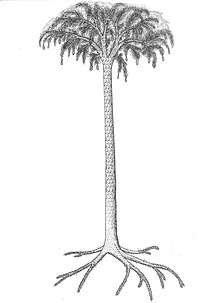 | |
| Reconstruction of a Lepidodendron plant | |
| Scientific classification | |
| Kingdom: | Plantae |
| Clade: | Tracheophytes |
| Clade: | Lycophytes |
| Classes | |
| |
The scientific names and the informal English names used for this group of plants are ambiguous. For example, "Lycopodiophyta" and the shorter "Lycophyta" as well as the informal "lycophyte" may be used to include the extinct zosterophylls or to exclude them.
Description
Lycophytes reproduce by spores and have alternation of generations in which (like other vascular plants) the sporophyte generation is dominant. Some lycophytes are homosporous while others are heterosporous.[5] When broadly circumscribed, the lycophytes represent a line of evolution distinct from that leading to all other vascular plants, the euphyllophytes, such as ferns, gymnosperms and flowering plants. They are defined by two synapomorphies: lateral rather than terminal sporangia (often kidney-shaped or reniform), and exarch protosteles, in which the protoxylem is outside the metaxylem rather than vice versa. The extinct zosterophylls have at most only flap-like extensions of the stem ("enations") rather than leaves, whereas extant lycophyte species have microphylls, leaves that have only a single vascular trace (vein), rather than the much more complex megaphylls of other vascular plants. The extinct genus Asteroxylon represents a transition between these two groups: it has a vascular trace leaving the central protostele, but this extends only to the base of the enation.[6] See § Evolution of microphylls.
Zosterophylls and extant lycophytes are all relatively small plants, but some extinct species, such as the Lepidodendrales, were tree-like, and formed extensive forests that dominated the landscape and contributed to the formation of coal.[6]
Taxonomy
Classification
In the broadest circumscription of the lycophytes, the group includes the extinct zosterophylls as well as the extant (living) lycophytes and their closest extinct relatives. The names and ranks used for this group vary considerably. Some sources use the names "Lycopodiophyta" or the shorter "Lycophyta" to include zosterophylls as well as extant lycophytes and their closest extinct relatives,[7] others use these names to exclude zosterophylls.[8][6] The name "Lycopodiophytina" has also been used in the inclusive sense.[9][10] English names, such as "lycophyte", "lycopodiophyte" or "lycopod", are similarly ambiguous, and may refer to the broadly defined group or only to the extant lycophytes and their closest extinct relatives.
The consensus classification produced by the Pteridophyte Phylogeny Group classification in 2016 (PPG I) places all extant (living) lycophytes in the class Lycopodiopsida.[11] There are around 1,290 to 1,340 such species.[12][13][11] For more information on the classification of extant lycophytes, see Lycopodiopsida § Classification.
Phylogeny
A major cladistic study of land plants was published in 1997 by Kenrick and Crane.[1] In 2004, Crane et al. published some simplified cladograms, based on a number of figures in Kenrick and Crane (1997). Their cladogram for the lycophytes is reproduced below (with some branches collapsed into 'basal groups' to reduce the size of the diagram).[14]
| ||||||||||||||||||||||||||||
In this view, the "zosterophylls" comprise a paraphyletic group, ranging from forms like Hicklingia, which had bare stems,[15] to forms like Sawdonia and Nothia, whose stems are covered with unvascularized spines or enations.[16][17] The genus Renalia illustrates the problems in classifying early land plants. It has characteristics of both the non-lycophyte rhyniophytes – terminal rather than lateral sporangia – and the zosterophylls – kidney-shaped sporangia opening along the distal margin.[18]
A rather different view is presented in a 2013 analysis by Hao and Xue. Their preferred cladogram shows the zosterophylls and associated genera basal to both the lycopodiopsids and the euphyllophytes, so that there is no clade corresponding to the broadly defined group of lycophytes used by other authors.[19]
|
"lycophytes" of other authors |
Some extinct orders of lycophytes fall into the same group as the extant orders. Different sources use varying numbers and names of the extinct orders. The following phylogram shows a likely relationship between some of the proposed Lycopodiopsida orders.
| Lycopodiopsida |
| ||||||||||||||||||||||||||||||
Evolution of microphylls
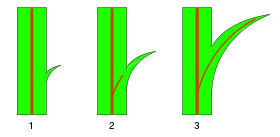
Within the broadly defined lycophyte group, species placed in the class Lycopodiopsida are distinguished from species placed in the Zosterophyllopsida by the possession of microphylls. Some zosterophylls, such as the Devonian Zosterophyllum myretonianum, had smooth stems (axes). Others, such as Sawdonia ornata, had flap-like extensions on the stems ("enations"), but without any vascular tissue. Asteroxylon, identified as an early lycopodiopsid, had vascular traces that extended to the base of the enations. Species in the genus Leclercqia had fully vascularized microphylls. These are considered to be stages in the evolution of microphylls.[20]
Gallery
- Lycopodites, an early lycopod-like fossil
 External mold of Lepidodendron from the Upper Carboniferous of Ohio.
External mold of Lepidodendron from the Upper Carboniferous of Ohio.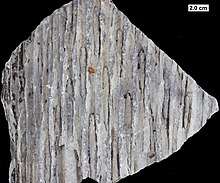 Lycopod bark showing leaf scars, from the Middle Devonian of Wisconsin.
Lycopod bark showing leaf scars, from the Middle Devonian of Wisconsin.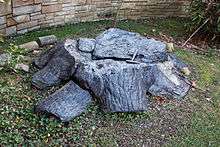 Base of a fossil lycopsid showing connection with stigmarian roots.
Base of a fossil lycopsid showing connection with stigmarian roots.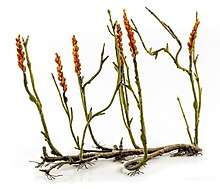 Reconstruction of a Silurian Zosterophyllum
Reconstruction of a Silurian Zosterophyllum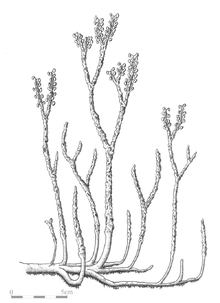 Reconstruction of Nothia aphylla
Reconstruction of Nothia aphylla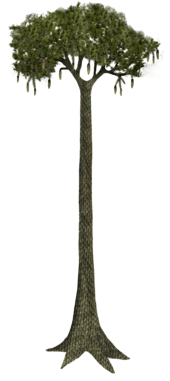 Reconstruction of Lepidodendron
Reconstruction of Lepidodendron Lycopod axis (branch) from the Middle Devonian of Wisconsin.
Lycopod axis (branch) from the Middle Devonian of Wisconsin.- Lycopodium dendroideum, a modern member of the Lycopodiales
.jpg) Isoetes melanospora, a modern member of the Isoetales
Isoetes melanospora, a modern member of the Isoetales
References
- Kenrick, Paul; Crane, Peter R. (1997). The Origin and Early Diversification of Land Plants: A Cladistic Study. Washington, D. C.: Smithsonian Institution Press. pp. 339–340. ISBN 978-1-56098-730-7.
- Rickards, R.B. (2000). "The age of the earliest club mosses: the Silurian Baragwanathia flora in Victoria, Australia". Geological Magazine. 137 (2): 207–209. Bibcode:2000GeoM..137..207R. doi:10.1017/s0016756800003800.
- McElwain, Jenny C.; Willis, K. G.; Willis, Kathy; McElwain, J. C. (2002). The evolution of plants. Oxford [Oxfordshire]: Oxford University Press. ISBN 978-0-19-850065-0.
- Ranker, T. A.; Hauler, C. H. (2008). Biology and evolution of ferns and lycophytes. Cambridge: Cambridge University Press.
- Eichhorn, Evert, and Raven (2005). Biology of Plants, Seventh Edition. 381-388.
- Mauseth, James D. (2014). Botany : An introduction to Plant Biology (5th ed.). Burlington, MA: Jones & Bartlett Learning. ISBN 978-1-4496-6580-7.
- Doweld, Alexander B. (2017). "(2499) Proposal to conserve the name Zosterophyllaceae against Sciadophytaceae (Fossil Lycopodiophyta: Zosterophyllopsida)". Taxon. 66 (1): 207–208. doi:10.12705/661.27.
- Taylor, T.N.; Taylor, E.L. & Krings, M. (2009). Paleobotany : The Biology and Evolution of Fossil Plants (2nd ed.). Amsterdam; Boston: Academic Press. ISBN 978-0-12-373972-8.CS1 maint: ref=harv (link)
- Kenrick, Paul & Crane, Peter R. (1997a). The Origin and Early Diversification of Land Plants: A Cladistic Study. Washington, D.C.: Smithsonian Institution Press. ISBN 978-1-56098-730-7.CS1 maint: ref=harv (link)
- Kenrick, Paul & Crane, Peter R. (1997b). "The origin and early evolution of plants on land". Nature. 389 (6646): 33–39. Bibcode:1997Natur.389...33K. doi:10.1038/37918.
- PPG I (2016). "A community-derived classification for extant lycophytes and ferns". Journal of Systematics and Evolution. 54 (6): 563–603. doi:10.1111/jse.12229.
- Callow, R.S. & Cook, Laurence Martin (1999). Genetic and evolutionary diversity: the sport of nature. Cheltenham: S. Thornes. p. 8. ISBN 978-0-7487-4336-0.
- Christenhusz, M. J. M., M.J.M. & Byng, J.W. (2016). "The number of known plants species in the world and its annual increase". Phytotaxa. 261 (3): 201–217. doi:10.11646/phytotaxa.261.3.1.
- Crane, P.R.; Herendeen, P. & Friis, E.M. (2004). "Fossils and plant phylogeny". American Journal of Botany. 91 (10): 1683–1699. doi:10.3732/ajb.91.10.1683. PMID 21652317.
- Edwards, D. (1976). "The systematic position of Hicklingia edwardii Kidston and Lang". New Phytologist. 76: 173–181. doi:10.1111/j.1469-8137.1976.tb01449.x.
- Taylor, Taylor & Krings (2009), p. 253.
- Kerp, H.; Hass, M.H. & Mosbrugger, V. (2001). "New Data on Nothia aphylla Lyon 1964 ex El-Saadawy et Lacey 1979, a Poorly Known Plant from the Lower Devonian Rhynie Chert". In Gensel, P.G. & Edwards, D. (eds.). Plants invade the Land : Evolutionary & Environmental Perspectives. New York: Columbia University Press. pp. 52–82. ISBN 978-0-231-11161-4.
- Taylor, Taylor & Krings (2009), p. 250.
- Hao, Shougang & Xue, Jinzhuang (2013). The early Devonian Posongchong flora of Yunnan: a contribution to an understanding of the evolution and early diversification of vascular plants. Beijing: Science Press. Fig. 6.8, p. 246. ISBN 978-7-03-036616-0.
- Taylor, Taylor & Krings (2009), p. 267ff.
External links
| Wikispecies has information related to Lycopodiophyta |
| The Wikibook Dichotomous Key has a page on the topic of: Lycopodiophyta |